As an Amazon Associate KitchenwareSets.com earns from qualifying purchases.
7 Genius Cozy Kitchen Aesthetic Ideas To Transform Your Space
Is your kitchen the one room in the house that feels more like a sterile laboratory than a welcoming sanctuary? You have all the functional pieces—the appliances, the countertops, the storage—but it lacks a certain soul, a warmth that invites you to linger over a cup of coffee or chat with family while you cook. It’s a common problem in a room so often designed for pure utility.
Many of us find our kitchens feel cold, clinical, and disconnected from the rest of our home’s personality. The hard surfaces, bright overhead lighting, and purely functional layout can create an environment that feels efficient but not comfortable. You want the heart of your home to actually feel like a heart: warm, alive, and full of character. But the thought of a full remodel is daunting and expensive.
The secret to a cozy kitchen aesthetic is blending warm colors, natural materials like wood and stone, layered lighting, and personal touches to create an inviting, comfortable space. It’s about thoughtfully transforming a purely functional room into the true heart of the home where people genuinely love to gather. As a design strategist, I’ve seen countless kitchens transformed from cold to cozy—it’s not about a huge budget, but about thoughtful, layered choices. This guide is filled with 7 genius, actionable ideas that will infuse that much-needed warmth, personality, and comfort right into the heart of your home.
Is Your Kitchen More Clinical Than Comfortable? Here’s How to Fix It
The key to fixing a clinical kitchen is to intentionally layer in elements that engage the senses and create a feeling of comfort and history. A cozy kitchen aesthetic blends warm colors, natural materials like wood and stone, varied lighting, and personal touches to transform a purely functional room into the true heart of the home where people love to gather. It’s about moving beyond mere function to create an atmosphere of welcome. You don’t need a complete overhaul; small, strategic additions can make a world of difference. By focusing on texture, soft light, and personal character, you can easily dial up the warmth and create a space that feels both beautiful and lived-in.
7 Genius Cozy Kitchen Aesthetic Ideas To Transform Your Space
Ready to turn your kitchen into the coziest room in the house? This curated list features the seven most impactful strategies for creating a warm, welcoming, and personal kitchen aesthetic. These ideas are rooted in top interior design principles and inspired by real-world transformations that consistently deliver that sought-after cozy atmosphere. Each idea is broken down into simple, easy-to-implement steps with visual inspiration, catering to various styles and budgets. Whether you’re a renter looking for temporary fixes or a homeowner ready for a weekend project, you’ll find actionable tips to make your kitchen a space you never want to leave.
1. Embrace Natural Materials & Warm Tones
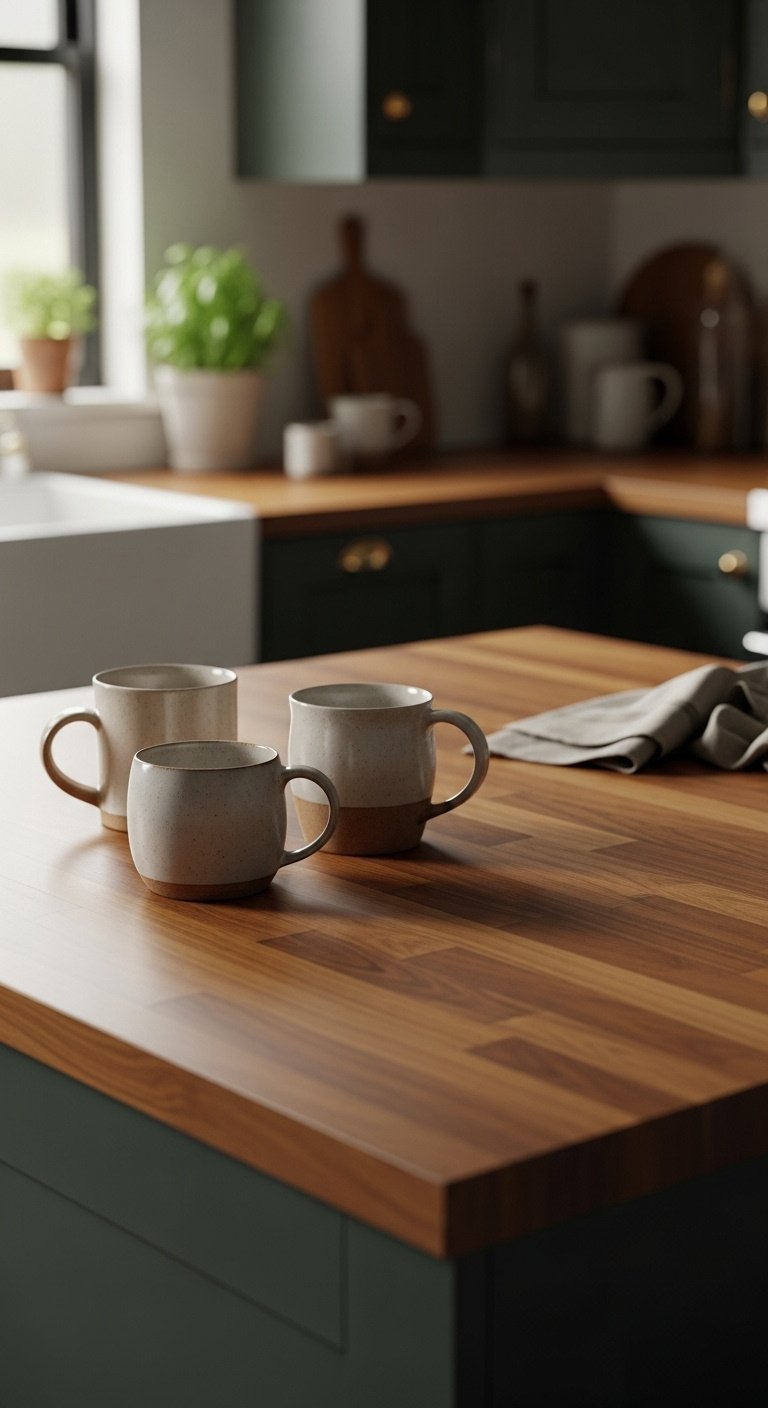
The fastest way to add warmth to a kitchen is by introducing natural materials and a warm color palette. This means swapping cold, sterile surfaces for materials with organic texture and depth. Think about rich butcher block countertops, terracotta floor tiles, or even just a warm beige paint on the walls. For cabinetry, consider stained wood or a deep, earthy color like forest green. These elements connect the space to nature and create an instant feeling of grounding and comfort.
DIY Project: Faux Wood Backsplash
- Materials Needed: Peel-and-stick wood-look vinyl planks, measuring tape, utility knife, degreasing cleaner.
- Step-by-Step Directions:
- Prep: Thoroughly clean your existing backsplash area to ensure it’s free of grease and grime. Let it dry completely.
- Measure & Cut: Measure the dimensions of your backsplash. Use the utility knife to carefully cut the peel-and-stick planks to size.
- Apply: Starting from one end, peel back a portion of the adhesive backing and carefully align the plank. Press firmly, smoothing out any air bubbles as you go.
- Stagger: For a natural look, stagger the seams of the planks in subsequent rows, just like real wood.
Pro-Tip: To make peel-and-stick applications look more permanent, apply a thin bead of clear caulk along the bottom edge where the backsplash meets the counter.
Pin this cozy color palette for your next kitchen refresh!
2. Master the Art of Layered Lighting
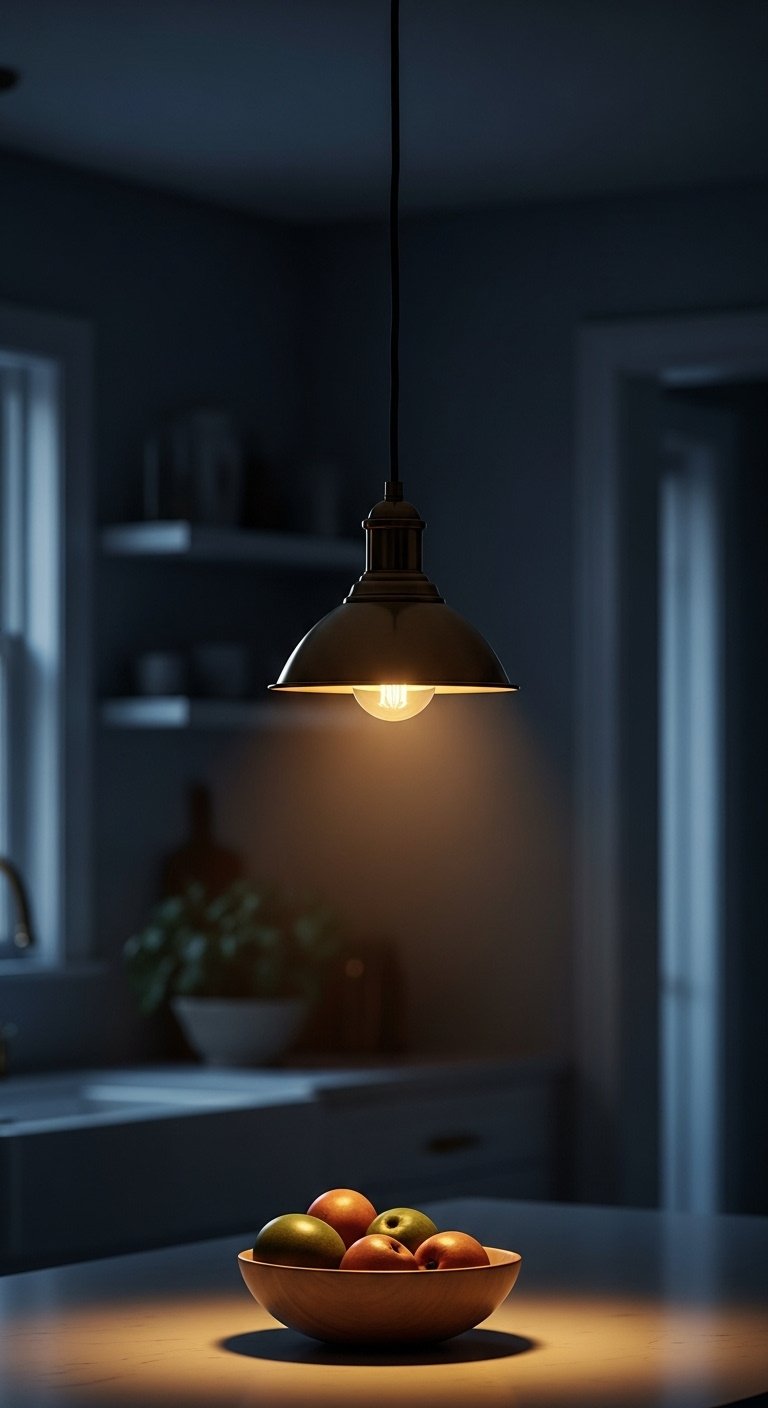
To create a truly inviting atmosphere, you must layer different types of lighting to control the room’s mood. A single, harsh overhead light makes a kitchen feel like a workspace, not a living space. Combine ambient light (from your main fixture), task light (like pendants over an island or under-cabinet strips), and accent light (like sconces or a small countertop lamp). Using fixtures in warm metals like unlacquered brass or aged copper and ensuring all bulbs have a warm glow will make the space feel moody and inviting in the evenings.
DIY Project: Instant Countertop Ambiance
- Materials Needed: Small accent lamp (6-10 inches tall), low-wattage warm LED bulb, an available outlet on your countertop.
- Step-by-Step Directions:
- Choose a Spot: Find a corner of your countertop that could use a warm glow, such as next to a cookbook stand or a fruit bowl.
- Select a Lamp: Pick a small lamp with a fabric or ceramic shade that complements your kitchen’s style. Vintage or thrifted lamps work beautifully here.
- Use a Warm Bulb: Insert a low-wattage (25-40 watt equivalent) LED bulb with a warm color temperature (around 2700K).
- Plug In & Enjoy: Place the lamp and turn it on in the evening for an instant cozy ambiance that softens the hard surfaces of the kitchen.
Lesson Learned: Always put your kitchen lights on dimmer switches. It’s the single most effective way to control the mood of the room from bright and functional to low and intimate.
Save this lighting tip to your “Dream Home” Pinterest board!
3. Introduce Soft Textures with Rugs & Linens
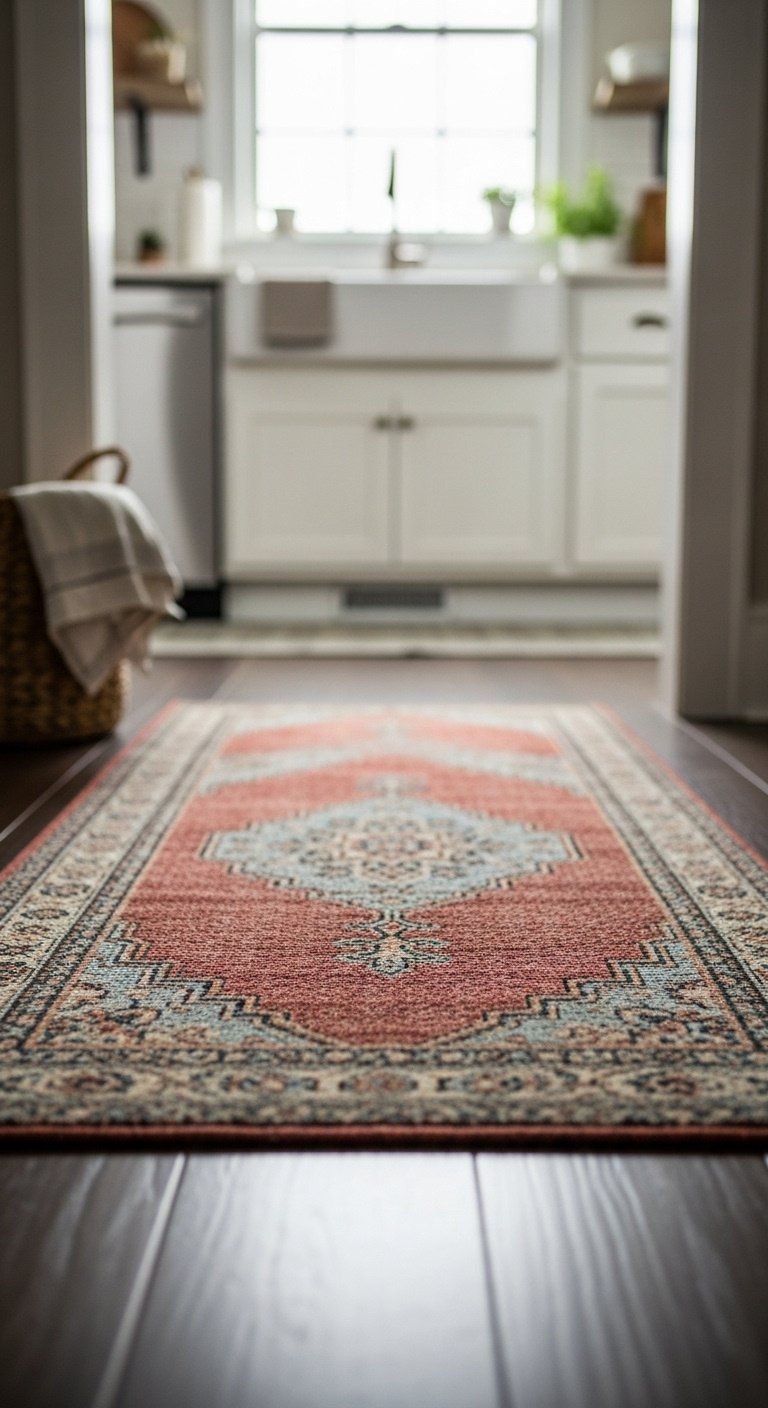
The best way to counteract the hard surfaces of a kitchen is to add soft furnishings and textiles wherever possible. Kitchens are full of stone, metal, and wood; textiles absorb sound and add a layer of physical and visual comfort. A runner rug introduces color and pattern while making the floor warmer underfoot. Simple cafe curtains soften window light, and linen tea towels or upholstered cushions on a bench bring in that much-needed texture.
DIY Project: No-Sew Cafe Curtains
- Materials Needed: One tension rod, two cafe curtain panels or a large linen tea towel, measuring tape.
- Step-by-Step Directions:
- Measure: Measure the inside width of your kitchen window frame.
- Adjust Rod: Adjust the tension rod so it’s slightly wider than your measurement.
- Thread Curtain: Slide the curtain panels or the folded tea towel onto the tension rod through the rod pocket.
- Install: Compress the tension rod and fit it snugly into place inside the window frame, typically halfway up the window. Adjust the curtain panels to be evenly spaced.
Pro-Tip: Choose a vintage-style flatweave runner for your kitchen. They are durable, hide crumbs well, and add an immediate layer of warmth and history to the space.
Love this look? Tap to see more cottage-style kitchen ideas!
4. Display Personality with Vintage Finds & Open Shelving
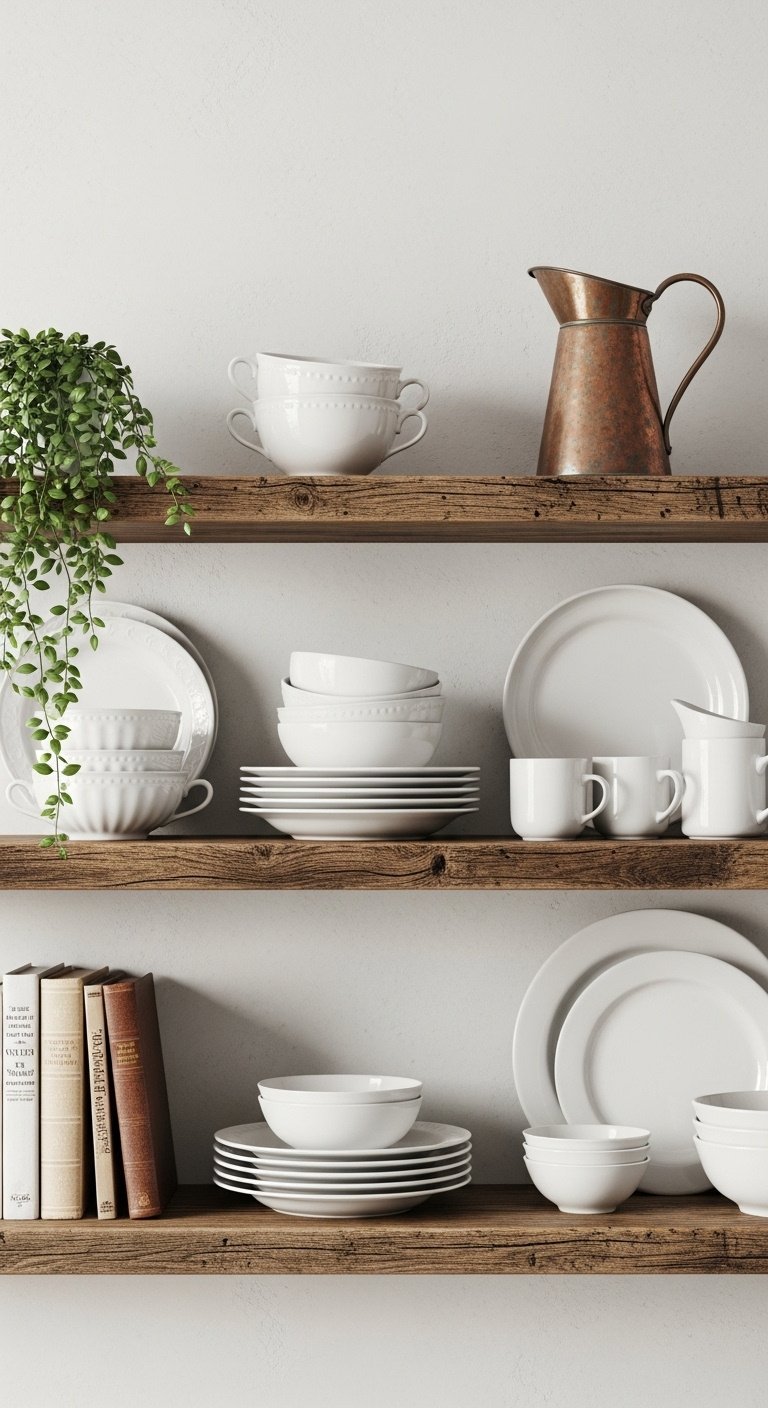
A cozy kitchen feels lived-in and personal, which is why displaying curated collections and vintage pieces is essential. Open shelving provides the perfect stage for showcasing items that tell your story: handmade pottery, stacks of favorite cookbooks, an antique silver teapot, or a collection of copper pitchers. Even without open shelves, you can lean a small piece of vintage art against your backsplash or use a beautiful old crock to hold utensils. These items add a layer of soul that new, mass-produced items can’t replicate.
DIY Project: Mini Vintage Gallery Wall
- Materials Needed: A collection of 3-5 vintage items (e.g., small paintings, copper molds, ceramic pitchers), temporary adhesive hooks, measuring tape.
- Step-by-Step Directions:
- Identify a Space: Find a small, empty wall space in your kitchen, like the side of a cabinet or a narrow wall between a door and a window.
- Arrange on Floor: Lay your vintage art or objects on the floor first to plan a pleasing gallery-style arrangement. A good rule of thumb is to create a loose triangle or grid.
- Measure & Mark: Measure the arrangement and transfer the key hanging points to the wall with a pencil.
- Hang Items: Apply the adhesive hooks according to the package directions and hang your vintage pieces to create an instant focal point with character.
Pro-Tip: When styling shelves, mix textures and heights. Place a tall ceramic pitcher next to a short stack of plates, and lean a small wooden cutting board against the back to create depth.
Click to save this shelf styling formula to your decor board!
5. Carve Out a Charming Breakfast Nook
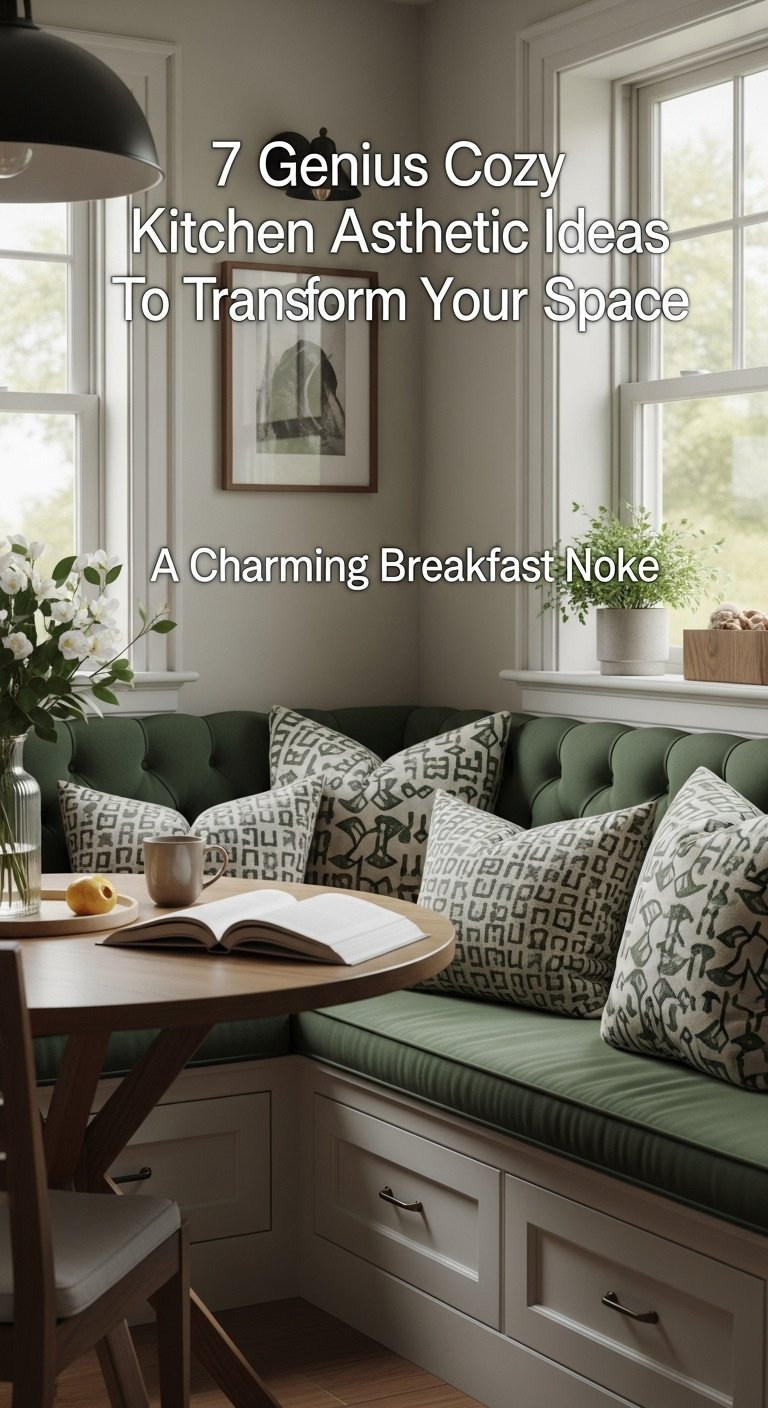
To make a kitchen a true gathering spot, create a dedicated, comfortable place for people to sit and connect. A breakfast nook, no matter how small, instantly adds a cozy, social element. This could be a full built-in banquette with upholstered cushions or simply a small vintage table and two chairs tucked into a corner. The key is to make it feel distinct from the “work” zones of the kitchen, signaling that this is a place for conversation and relaxation. A low-hanging pendant light over the table will further define the space and enhance its intimacy.
DIY Project: The “Instant Nook” Bench
- Materials Needed: A small bench (storage bench is a bonus), 2-3 throw pillows with cozy covers (linen, wool, velvet), a small throw blanket.
- Step-by-Step Directions:
- Find a Corner: Identify an underutilized corner or a clear wall in your kitchen.
- Place the Bench: Position the bench flush against the wall(s).
- Add Pillows: Arrange the throw pillows in the corner and along the back of the bench for comfort and style. Mix patterns and solids for interest.
- Drape the Blanket: Casually drape a soft throw blanket over one end of the bench to add another layer of texture and invite people to sit.
Lesson Learned: You don’t need a built-in banquette to create a nook. A simple bench and a small table pushed against a wall can create the same intimate feeling for a fraction of the cost and effort.
Want to build your own breakfast nook? Save this for inspiration!
6. Add Character with a DIY Beadboard Backsplash
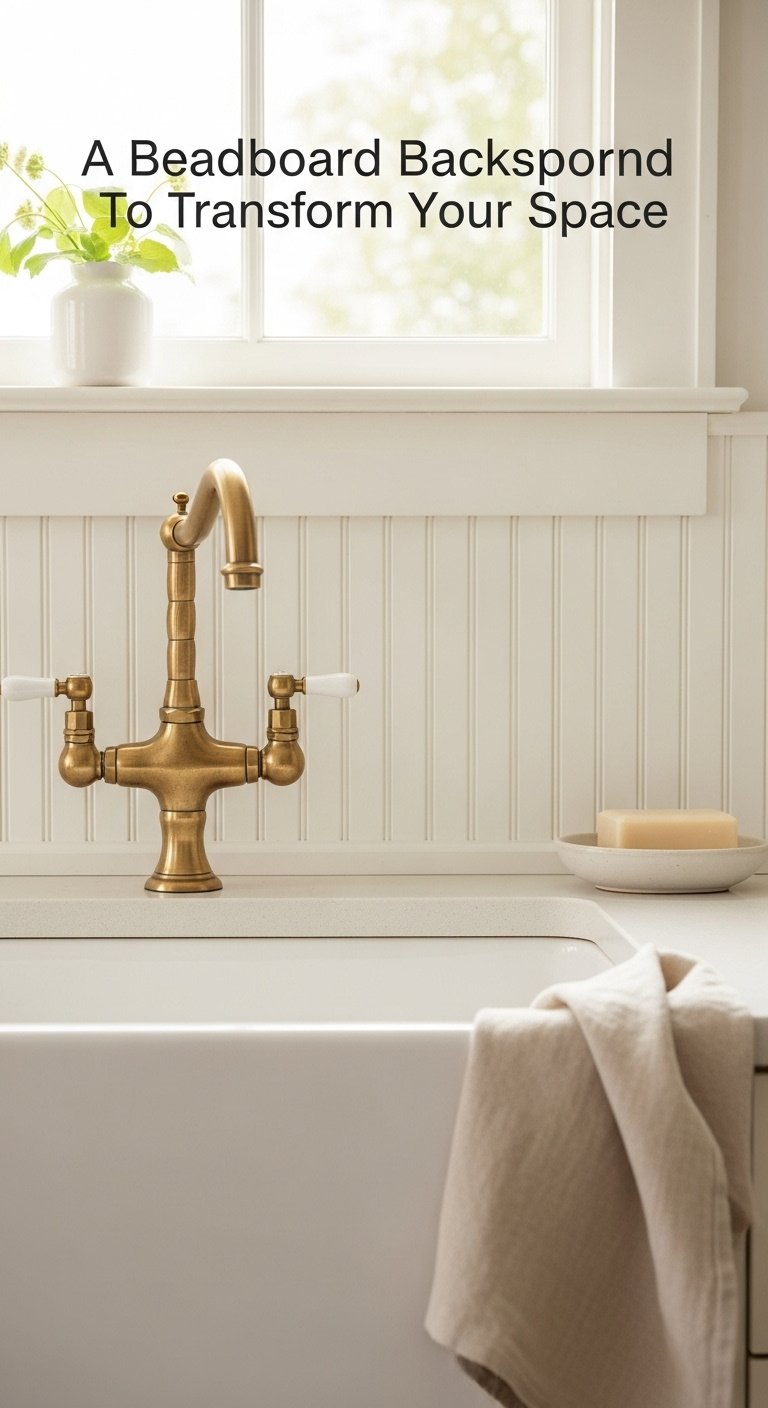
One of the most effective ways to add cozy charm is by introducing architectural details that add texture and a sense of age. Beadboard or shiplap instantly brings a warm, cottage, or farmhouse feel to a kitchen. It breaks up flat, boring walls and provides a textured backdrop that feels much cozier than simple drywall or sleek tile. It pairs beautifully with classic elements like a farmhouse sink and adds a layer of character that makes a new kitchen feel like it has a history.
DIY Project: Easy Beadboard Wallpaper Backsplash
- Materials Needed: Beadboard wallpaper, wallpaper smoothing tool, measuring tape, utility knife, level, all-purpose cleaner.
- Step-by-Step Directions:
- Prep the Wall: Clean the backsplash wall thoroughly and ensure it is smooth and dry.
- Measure and Cut: Measure the height and width of your backsplash area. Cut the beadboard wallpaper to size, leaving a little extra to trim.
- Apply: Following the manufacturer’s instructions (pre-pasted or peel-and-stick), apply the first panel of wallpaper to the wall, using a level to ensure it’s perfectly vertical.
- Smooth and Trim: Use the smoothing tool to work out any air bubbles. Use the utility knife to trim the excess paper at the countertop and cabinets for a clean finish. Repeat for the remaining area.
Pro-Tip: Paint your beadboard wallpaper with a durable, semi-gloss paint in a warm, cozy color. This makes it wipeable, waterproof, and look exactly like real wood.
Pin this budget-friendly backsplash idea for later!
7. Infuse Life with a Windowsill Herb Garden
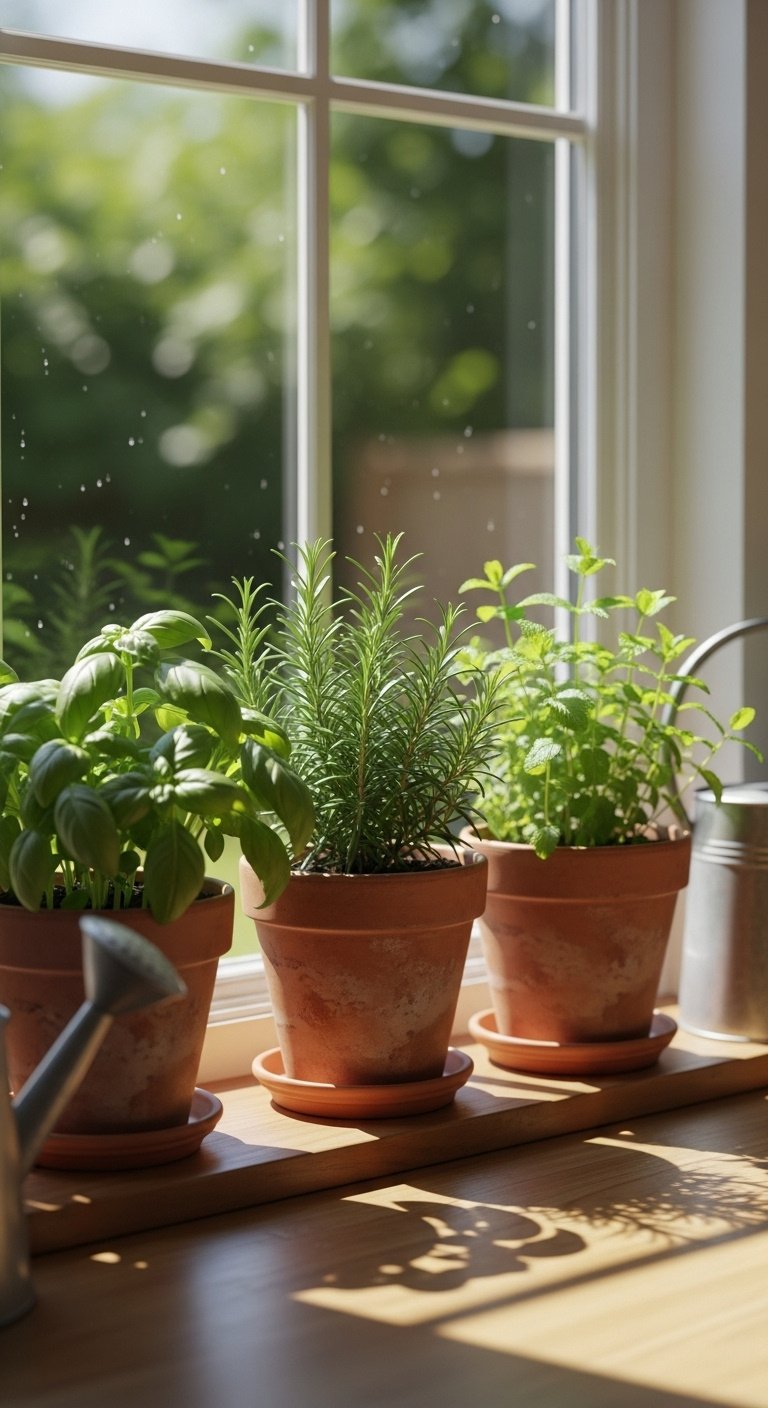
Nothing makes a space feel more alive and welcoming than bringing nature indoors with plants and greenery. A small herb garden on a sunny windowsill is the perfect way to do this in a kitchen. Not only does it add a pop of vibrant green color and life, but it’s also functional, providing fresh flavors for your cooking. The rustic look of terracotta pots adds another layer of natural, earthy texture that contributes beautifully to the cozy aesthetic.
DIY Project: Simple Windowsill Herb Garden
- Materials Needed: 3-4 small herb plants (like basil, mint, rosemary), 3-4 terracotta pots with saucers, potting mix, small gardening trowel.
- Step-by-Step Directions:
- Pot the Herbs: Fill the bottom of each terracotta pot with a small amount of potting mix. Gently remove the herb plant from its nursery container, loosen the roots, and place it in the new pot.
- Add Soil: Fill the space around the plant with more potting mix, patting it down gently.
- Water: Water each herb thoroughly until water drains from the bottom into the saucer.
- Arrange: Place your newly potted herbs on a sunny windowsill, ready for cooking and enjoying.
Pro-Tip: Choose herbs you’ll actually cook with to make your garden both beautiful and functional. Mint is great for drinks, basil for pasta, and rosemary for roasts. This makes it a rewarding part of your kitchen routine.
Ready to start your own herb garden? Save this simple how-to!
Key Takeaways: Your Quick Guide to cozy kitchen aesthetic
- Warmth is Key: Prioritize warm color palettes (beiges, greens, terracotta) and natural materials like wood and stone.
- Layer Your Light: Combine overhead, task (pendants), and ambient (lamps, sconces) lighting on dimmers to control the mood.
- Soften the Surfaces: Use rugs, runners, cushions, and window treatments to add texture and absorb sound.
- Make it Personal: Display items that tell your story—vintage finds, handmade pottery, cookbooks, and art.
- Add Life: Greenery, whether from a potted plant or a windowsill herb garden, instantly makes a space feel more alive and welcoming.
People Also Ask About cozy kitchen aesthetic
How do I make my small kitchen cozy?
To make a small kitchen cozy, focus on vertical space with open shelving, use a warm-toned runner to elongate the room, and incorporate layered lighting with under-cabinet lights and a small countertop lamp. Choose a warm, light paint color to keep the space feeling bright but inviting. Decluttering is also crucial to create a sense of calm and order.
What colors make a kitchen feel warm and cozy?
Warm and cozy kitchen colors include soft beiges, creamy whites, muted golds, and rich earthy tones like terracotta, forest green, deep violet, or chocolate brown. These hues can be used on walls or cabinets. Accenting with warm metals like unlacquered brass or aged copper on hardware and fixtures also enhances the cozy feeling.
Can a modern kitchen still have a cozy aesthetic?
Absolutely. A modern kitchen can be made cozy by introducing organic textures and natural materials. Pair sleek, flat-panel cabinets with a warm butcher block countertop, add a vintage-style runner on the floor, and incorporate handmade pottery on open shelves. Soft, layered lighting with dimmable fixtures is key to softening modern lines and creating an inviting atmosphere.
Final Thoughts
Creating a cozy kitchen is about more than just following a design trend; it’s about crafting a space that nurtures, welcomes, and encourages connection. It’s about making the functional heart of your home feel as comfortable and personal as your living room. By thoughtfully layering in warmth through color and materials, softening the space with textiles, personalizing it with items you love, and adding a touch of life with greenery, you can transform any kitchen—big or small, modern or traditional—into a truly cozy haven.
Which of these cozy ideas are you most excited to try in your kitchen? Let me know in the comments below
